
CCDSoft Version 5
SBIG Advanced Camera Control

CCDSoft Version 5
What is CCDSoft?
CCDSoft is a Microsoft Windows-based CCD camera control, data reduction, image processing
and astronomical research application for amateur and professional astronomers.
Additionally, CCDSoft integrates with TheSky6 Professional Edition for the ultimate in
hands-on or automated telescope, CCD camera
Why Use CCDSoft?
CCDSoft will become the data acquisition tool for your observatory. See below for just a
few reasons...
Integrated Software for Observatory Control
CCDSoft is part of an integrated software suite that can observatory control your
observatory hardware. You can enjoy the benefits of integration by your increased
productivity in image acquisition and data reduction. Check out our discoveries page.
Dependability
Software Bisque has been providing astronomy software for over 20 years, longer than any
other company. Our users continuously provide suggestions and ideas for improvement. We
strive to continue our tradition of innovation in the astronomical community.
Quality
Our products have gained world-wide acceptance for many reasons. We work hard to provide a
friendly, intuitive user interface to all our products. Rigorous testing methods are used
to ensure CCDSoft and other products from Software Bisque are bullet-proof.
Nothing is more demanding than running an all night, unattended script, and CCDSoft has
been performing under these conditions for years. In fact, CCDSoft is a core component of
a completely automated and unattended satellite image-acquisition observatory at Edward's
Air Force base.
Scripting/Automation Model
Using Visual Basic, VisualScript or JavaScript, you can write custom scripts to control
your CCD camera, filter wheel, telescope — even your dome. All our software has been
fundamentally designed with integration in mind and takes advantage of the latest software
technologies to accomplish this.
Comprehensive Manual and Context-Sensitive Help Files
In addition to CCDSoft's extensive 370 page PDF User’s Manual, context-sensitive help
is available at all times. So whether in the field or at your desk, quick answers to your
questions are always available.
Note: the printed manual is sold separately.
Technical Support
Software Bisque's support team consists of many experienced CCD astronomers who regularly
spend their free time at the telescope. Combined, we have over 50 years of experience CCD
imaging on staff. You can be sure to find an answer to your question no matter how simple
or difficult. Additionally, free updates are available 24-hours a day via our Downloads
page.
CCDSoft: A Friendly, Dependable Tool
If you are an experienced observer, you know the necessity of highly dependable
hardware. This applies to your software as well. Nature provides enough obstacles to
overcome and you don't want your software to become another one.
CCDSoft was written and tested by experienced observers. Hundreds of hours of testing
under actual observing conditions provided the insight for developing the CCDSoft user
interface to ensure that you spend your time gathering data instead of fumbling in the
dark.
By combining power with ease of use, CCDSoft is charting a new course for astronomical
image processing software. At Riverside Telescope Makers Conference one year, we left our
computer momentarily unattended and came back to find two 10-year-olds taking CCD images!
You are in control of your CCD camera, and not the other way 'round.
Not only is CCDSoft the best value in CCD camera control software, it is part of a
complete observatory control package. When you choose a program for controlling your CCD
camera, only CCDSoft makes sense. Here are a few reasons
Scripting + Software Integration = Productivity
CCDSoft has a powerful object model for scripting. See the Scripted Operation topic in
CCDSoft's Help file for details.
When you use an integrated package for acquiring your CCD images, your productivity will increase dramatically. The benefits of software apply to any telescope system! Whether you are manually pointing your telescope using encoders, or have a fully robotic system, CCDSoft will automatically stamp your FITS images with the important information required for scientific processing of the image.
This provides benefits that are almost unfair when compared to competing software. For example, a recent survey indicates that most people doing accurate astrometry spend on average 20 minutes to determine the coordinates of unknown objects on an image. With CCDSoft/TheSky, a single mouse click computes an astrometric plate solution in seconds.
This level of integration simply cannot be attained by collecting myriad software for observatory control from different vendors.
Here are two specific examples of how this increase in productivity has proven indispensable:
Case History #1
Amateur Tim Puckett and his supernova search team has discovered 58 supernovas to date.
Many team members use the powerful combination of CCDSoft, TheSky and Orchestrate. Why has
this team been so successful making discoveries — comparable to the professional
supernova patrols? Productivity. Using CCDSoft to control his CCD camera, Tim optimizes
precious observing time through automated, scripted equipment control. CCDSoft
automatically saves files for you. No typing in file names, observation times, image
coordinates, and the like during data acquisition.
Case History #2
When the United States Air Force needed a system to acquire images of hundreds of
satellites nightly for Space Command Center (NORAD), Software Bisque provided the means to
do so. Human intervention would make this task impossible. The solution? CCDSoft, used in
concert with TheSky, gracefully (and inexpensively) accomplished the task. This software
duo is so well integrated that the telescope slews to the next target satellite while the
CCD camera is downloading the previous image to maximize efficiency!
|
|||
|
|
CCDSoft's Camera Control Window: Setup Tab |
Camera control Color tab for acquiring color CCD images. Take any number of LRGB images — with any number of Luminance, Red, Green, and Blue channels, all while autoguiding. For example, automatically acquire the data for a series of 3 LRGB images composed of 6 L channel images, 4 R, 5 G and 10 B images. The file name of the automatically saved image contains the color channel information.
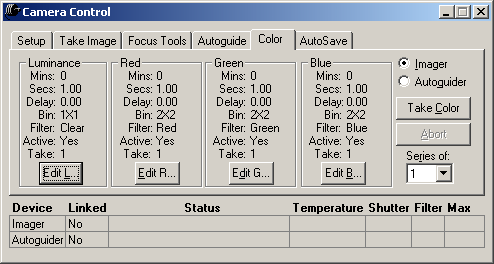
CCDSoft's Camera Control Window: Color Tab
Intuitive control of Autoguider.
Continuously autoguide while collecting images (take multiple exposures - LRGB channels, etc.).
Autoguider treated equal to Imager. The software does not impose upon you what can do with the Autoguider as compared to the Imager.
It is possible to have your autoguided images being reduced while autoguiding (useful when autoguiding on a really faint, faint, object and you need to apply a 20+ dark frames).
All of the Imager's options are accessible for Autoguiding.
Easily “Take Image” with Autoguider.
Easily focus the Autoguider.
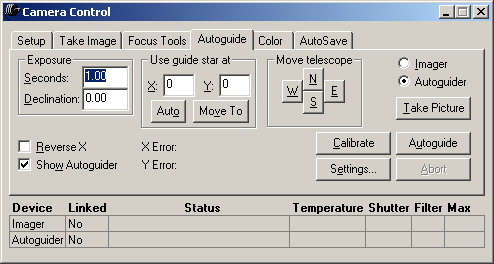
CCDSoft's Camera Control Window: Autoguide
Tab
Camera control is integrated with Image Reduction "groups" (images can be reduced during acquisition — post acquisition reduction is also possible).
“Hold down” relay buttons to move (slew) your telescope.
Camera status is always displayed on the Camera Control window and status contains detailed status descriptions.
Image Reduction groups — save n number of different groups of reduction frames (bias, dark, or flat frames).
Temperature is always displayed for both the Imager and Autoguider.
Easily switch between Autoguider/Imager control.
All autoguiding functions available to Imager and all Imager functions available to Autoguider.
Easily move telescope to center your desired object (“hold down” buttons).
Easily move guide star to any pixel on your CCD.
Easily Autoguide with the Imager.
Simultaneously autoguide with two cameras!
Real-time button for moving telescope! The duration depends on how long you hold down the button.
Vector-based autoguiding allows the CCD detector to be oriented at any angle during autoguiding.
Graphically view Autoguider calibration results. Excellent debugging tool.
Autoguiding is computed based on speeds for all four independent axes North, South, East and West.
Use a Filter wheel on Autoguider!
In conjunction with TheSky, the telescope's declination is automatically accounted for when calibrating Autoguider and Autoguiding.
When CCDSoft is used in conjunction with TheSky, images automatically have right ascension, declination and the object's named stamped in the FITS header.
In conjunction with TheSky, AutoSave images automatically use the target object's name as part of the file name.
Improved menu layout.
Automatically retrieve a comparison Digitized Sky Survey image for any of your Fits images that contain the World Coordinate System.
CCDSoft version 5 becomes even more powerful when used in conjunction with TheSky Astronomy Software. Here are many of the integrated features.
The FITS header is automatically saved with the following parameters:
Telescope’s current right ascension and declination.
Telescope’s current altitude and azimuth.
Object Name.
Longitude.
Latitude.
Julian Day.
Acquired images are automatically saved with object name as part of the file name (for example, 0000001.HorseHeadNebula.FIT)
AutoAstrometry/Add World Coordinate System performs automated astrometry and automatically adds the World Coordinate System to the FIT header.
The telescope's motorized focuser can be adjusted from within CCDSoft.
During a slide show, images acquired by CCDSoft (for example, images that have the right ascension and declination or object name in the header) have the corresponding object “found” in TheSky! If TheSky’s Object Information dialog box shows the Multimedia tab, a thumbnail image of the object is shown for quick and easy comparison (great for supernova searches).
TheSky is launched automatically when CCDSoft needs services provided by TheSky (for example, AutoAstrometry/Add WCS).
Slew your telescope directly from a CCDSoft image once “AutoAstrometry/Add World Coordinate System” has been performed. Excellent for centering. Merely right click the desired object in your image and click the “Slew To" command. Centering objects has never been easier.
Differing declinations are automatically accounted for when calibrating and during Autoguiding.
Once “AutoAstrometry/Add WCS” is performed, click Tools | Star Chart to have an TheSky automatically generate the exact star chart (that is, a star chart that has the same date, time, location, rotation, right ascension, declination and scale) and display this star chart in CCDSoft. Great for research and discovery work.
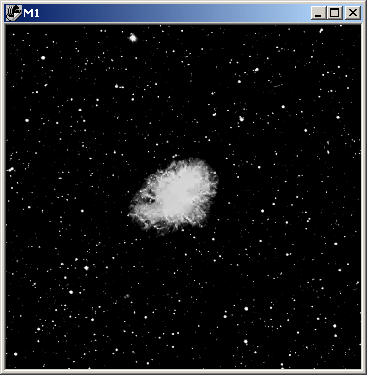
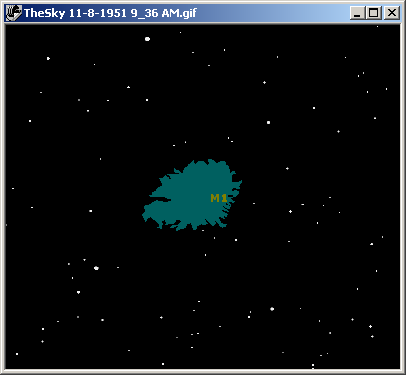
CCDSoft's Sky Chart Feature - Crab Nebula From the DSS (left) And Matching Sky Display (right)
By simply
choosing a folder(s) of FITS images you can perform numerous types of data analysis on the
images. These functions all tap the extensive database resources of TheSky Level IV.
Perform AutoAstrometry and add World Coordinate System data to the image. Once added, equatorial coordinates of every pixel in the image is always available.
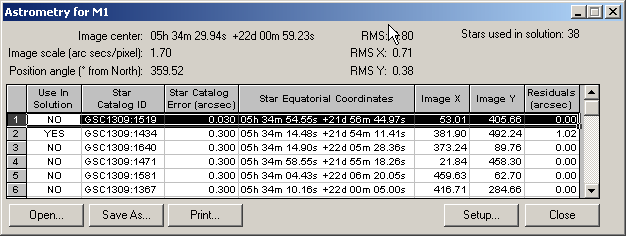
CCDSoft's AutoAstrometry Window
Create an “inventory” of all celestial objects on the image with x,y position and magnitude.
Perform comparative searches by aligning (sub-pixel translation and rotation) images and blinking them.
Minor Planet search function finds moving objects on a series of three or more images, even with extremely faint objects.
Supernova search function zooms to galaxies present on the image for further inspection.
Automatically generate reports in the format required by the Minor Planet Center (MPC).
Generate Light Curves (in both text and graphical form) of both Variable Stars and Minor Planets. Simply click on the various graphed points to view the corresponding image. The Minor planet position is computed by TheSky.
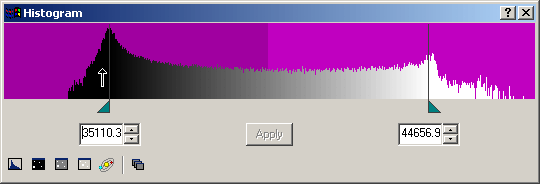
CCDSoft's Histogram Window (Wide)
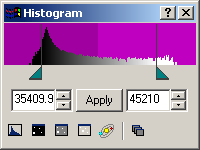
CCDSoft's Histogram Window (Small)
Using the new Color tab in the Camera control window to acquire color images, its easily combine them. The red, green and blue channels can even acquired at different bin modes than the Luminance channel.
View and edit the FITS file headers. Add or change or delete keyword values.
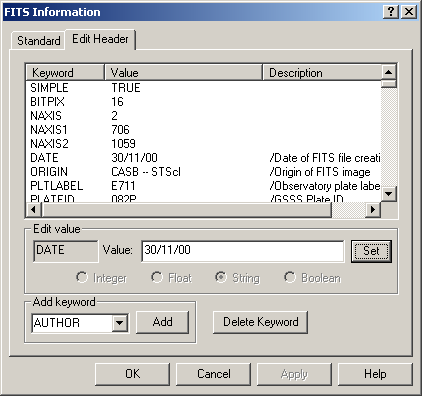
CCDSoft's
FITS Header Editor
Revised:
October 16, 2007 08:31:42 AM.
Copyright © 2005 Santa Barbara Instrument Group, Inc. All rights reserved.
Please report any problems with this page directly to the Webmaster